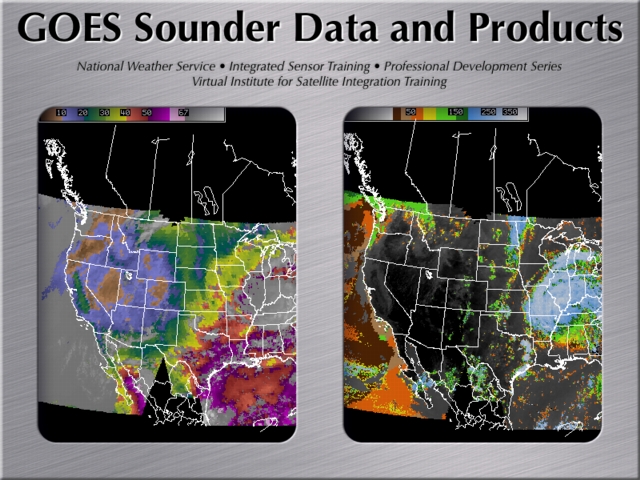
(1) Introduction
This 60-minute introductory-level teletraining module updates the original "GOES Sounder Data and Products" lesson (Bachmeier et al., 2000) VISITview lesson, and provides an introduction to the data and products available from the latest generation of GOES Sounder instruments, along with examples of sounder Derived Product Imagery (DPI) and their applications to weather analysis and forecasting. Special attention will be given to the recent change to Single Field of View (SFOV) sounder DPI in AWIPS, as well as the importance of applying an appropriate image enhancement (color table) to the derived products. (new lesson created January 2006)
(2) Teletraining file installation instructions
(3) Training lesson options:
(A) Interactive VISITview teletraining session. (To be used with a VISIT instructor leading the session). Click here to signup for teletraining. The session will last about 60 minutes. This teletraining session uses the VISITview software, where a Windows PC (with 128 MB RAM or greater) with an Internet connection is needed.
(B) Local VISITview lesson - This is the same version of the lesson
used in a "live" VISITview teletraining session, but no connection
is made to an external VISITview server. You download the lesson file
and go through the lesson on your own in "local mode"
using the visitlocal.bat file. Instructor Notes are not included
in this lesson version, but can be viewed in a separate Web browser (
or printed out beforehand).
(C) Audio playback  - This VISITview lesson file contains recorded audio and instructor annotations, and can be viewed at any time. Instructions for viewing audio playback lessons can be found here. Certificates of completion for NOAA employees can be obtained through local SOOs. A list of post-lesson questions can be found here which can be used as an applied test/certification of completion. - This VISITview lesson file contains recorded audio and instructor annotations, and can be viewed at any time. Instructions for viewing audio playback lessons can be found here. Certificates of completion for NOAA employees can be obtained through local SOOs. A list of post-lesson questions can be found here which can be used as an applied test/certification of completion.
You may either request a DVD (with all VISIT lesson audio playback files) -OR-
download this individual VISIT lesson audio playback file (it is 277 MB in size) from the following site:
ftp://ftp.ssec.wisc.edu/visit/sounder_2006jan25audio.zip
(4) References/Additional Links
 Suggested Enhancements for AWIPS GOES Sounder Derived Products Suggested Enhancements for AWIPS GOES Sounder Derived Products 
Realtime GOES sounder data and products on the Web:
- NOAA/NESDIS Operational Products Development Branch
- CIMSS Realtime GOES Products
- CIMSS GOES Sounder Derived Products Collaboration site
- RAMSDIS Online
- RAMSDIS Online - Experimental Products
References:
-
Bayler, G. M., R. M. Aune, and W. H. Raymond, 2001: NWP cloud initialization using GOES sounder data and improved modeling of non-precipitating clouds. /Mon. Wea. Rev/., 128, 3911-3920.
- Daniels, J. M., T. J. Schmit, and D.W. Hillger, 2001: GOES-11 Science Test: GOES-11 Imager and Sounder Radiance and Product Validations. NOAA Technical Report NESDIS 103, U.S. Department of Commerce, Washington, DC.
- Dostalek, John F. and Timothy J. Schmit, 2001: Total precipitable water measurements from GOES sounder derived product imagery. /Wea. Forecasting/, *16*, 573-587.
- Ellrod, Gary P., Nelson, James P., Witiw, Michael R., Bottos, Lynda, Roeder, William P. 2000: *Experimental GOES Sounder Products for the Assessment of Downburst Potential.* /Weather and Forecasting/: Vol. 15, No. 5, pp. 527–542.
- Hillger, D. W., T. J. Schmit, and J. M. Daniels, 2003: Imager and Sounder Radiance and Product Validations for the GOES-12 Science Test, NOAA Technical Report 115, U.S. Department of Commerce, Washington, DC.
- Li, J., C. C. Schmidt, J. P. Nelson III, T. J. Schmit, and W. P. Menzel, 2001: Estimation of total atmospheric ozone from GOES sounder radiances with high temporal resolution. /J. Atmos. Oceanic Technol., /18, 157-168.
Ma, X. L., T. Schmit, and W. L. Smith, 1999: A non-linear physical retrieval algorithm - its application to the GOES-8/9 sounder. /J. Appl. Meteor./, *38*, 501-513.
- Schmit T. J., W. F. Feltz, W. P. Menzel, J. Jung, A. P. Noel, J. N. Heil, J. P. Nelson III, G. S. Wade, 2002: Validation and use of GOES sounder moisture information, /Wea. Forecasting/, *17*, 139-154.
- Schreiner, A. J., T. J. Schmit, and R. M. Aune, 2002: Maritime inversions and the GOES sounder cloud product. /Nat. Wea. Assoc. Digest/, *26*, 1,2 27-38.
- Schreiner, Anthony J., Timothy J. Schmit, and W. Paul Menzel, 2001: Observations and trends of clouds based on GOES sounder data. /J. Geophys. Res./, *106*, 20,349-20,363.
- Images of satellite-derived cloud top pressure for the contiguous United States, Schreiner et al., Proceedings of the National Weather Association Conference, pp 35, December 3-8 1995.
- Derived Product Imagery from GOES-8, Hayden, C.M., G.S. Wade, and T.J. Schmit, Journal of Appiled Meteorology, 35, pp 153-162, 1996.
- Application of GOES-8/9 Soundings to Weather Forecasting and Nowcasting, Menzel et al., Bulletin of the American Meteorological Society, 79, 1998.
- Satellite Meteorology: Using the GOES Sounder (COMET CD-ROM, September 1998)
(5) Points of contact:
|

 - This VISITview lesson file contains recorded audio and instructor annotations, and can be viewed at any time. Instructions for viewing audio playback lessons can be found here. Certificates of completion for NOAA employees can be obtained through local SOOs. A list of post-lesson questions can be found here which can be used as an applied test/certification of completion.
- This VISITview lesson file contains recorded audio and instructor annotations, and can be viewed at any time. Instructions for viewing audio playback lessons can be found here. Certificates of completion for NOAA employees can be obtained through local SOOs. A list of post-lesson questions can be found here which can be used as an applied test/certification of completion.
 Suggested Enhancements for AWIPS GOES Sounder Derived Products
Suggested Enhancements for AWIPS GOES Sounder Derived Products 





